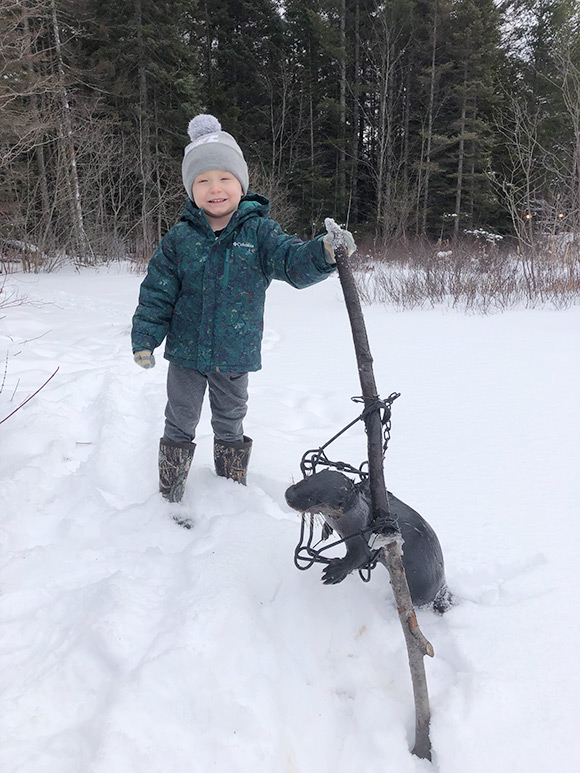 Team Fur News - September 2023
Team Fur News - September 2023
Anticipation
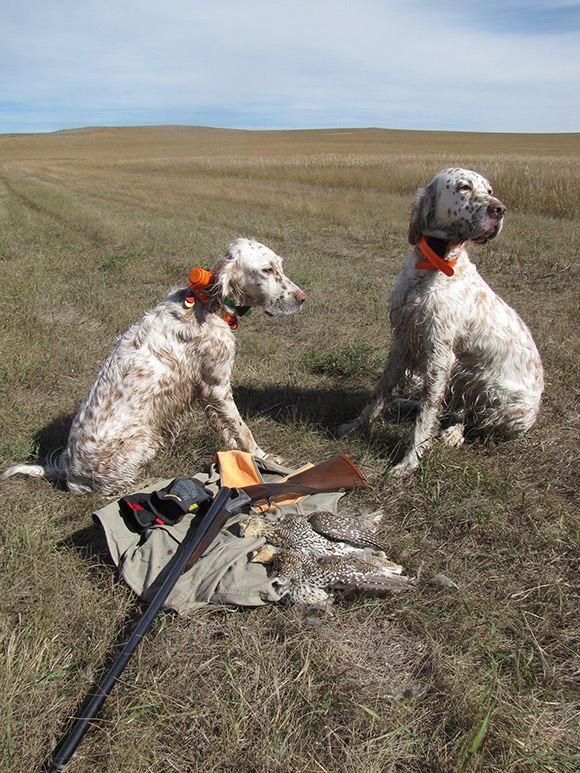
Harry and Ellen with a brace of South Dakota Sharptails.
September marks the beginning of the five months I anticipate most every year. Why September? It represents the start of another autumn, fresh hunting seasons. More importantly, it heralds the arrival of my absolute favorite hunt: sharptails. I’ve lived to hunt sharptails for more than 20 years now, ever since the very first time I experienced them.
Sharptails, if you’re not familiar, are prairie grouse. They live in brush-laden coulees and draws on landscape-scale grasslands. Visualize a great big valley cutting through a horizon-vast expanse of calf-high grass. Cover the flanks of the valley, especially the side draws, in patches of woody shrubs like buffaloberry, snowberry, chokecherries, maybe some sumac and sagebrush. There’s a vernal (spring only) creek in the valley bottom, dotted with clumps of cottonwoods, sage, grass and cactus. The valley’s headwater end sports a plum thicket. Ripe purple fruits hang heavy on branches and litter the ground beneath leaves yellowing under the sun. A sweet plum scent summons everything from mule deer and whitetails to coons and sharptails.
Why sharptails? I love the grouse itself; the mottled brown feathers, that purple male neck patch, the yellow strip above the eyes and especially the way they “bubb-bupp,” a laughing sound, as they flush. I love being in sharptail habitat, the vast empty wildness of it. I love the miles walked following bird dogs. And I especially love how my English setters have related to sharptails. To witness a big, happy, orange belton English setter galloping head high, feathered tail flowing, across the prairie on a 60-degree, late September, bluebird Dakota day makes my heart sing like no other hunt can.
Sure, I like to hunt deer – both muleys and prairie whitetails happen to like sharptail country, too. Pronghorns are my favorite big game. Elk hunting is cool, when you can get into them. But sharptails over the dogs…that’s prairie magic!
Last September, my passion for sharptails ebbed some when I lost my best buddy setter, Harry, to cancer. Diagnosed with that dread in April, with Pine Bluffs Veterinary Clinic help, we kept him happy and active, like nothing was wrong, until mid-September. Then he stopped eating and simply went down.
Losing Harry hurt, hard. His sister, Ellen, is a fine sharptail hunter, but Harry had something – perhaps a bit of clown – that made him special. Sharptails weren’t his birds. He loved galloping through frozen cattails to point big rooster pheasants. But more than that he loved hunting with me, and I reveled in sharing the field with him. We were a team.
So, it wasn’t until nearly October last year that I got Ellen and young Willa out for sharptails. Southeastern Wyoming was a sharptail desert – no habitat – so we headed north, to the Thunder Basin National Grassland. Drought hammered grouse reproduction making for slim pickings, but we managed to find birds and I scratched down a pair, blooding puppy Willa to my passion. She was uncertain about the strange bird – she’d only seen training chukars before – but I suspect that this fall she’ll start showing me what she is made of.
I owe some of my sharptail passion to the two South Dakotans who introduced me to the birds. In September of 2001, I embarked on a six-week, four-state camping junket to hunt all the lower 48 states’ forest and prairie grouse – research and photos for my book, “The Wild Ones: A Quest for North America’s Forest & Prairie Grouse.”
My first stop was South Dakota, for sharptails and prairie chickens. Mark Kayser, then media liaison for the South Dakota Department of Tourism, connected me with hunting guide Bruce “Wickerbill” Crist and insurance agent Chris Hipple, of the Pierre newspaper family.
Chris and I hunted coulees adjoining the Missouri River and moved a decent number of birds. (After getting skunked on my own on the Fort Pierre National Grasslands the day before, this was a revelation.) I won’t forget how Chris’s black Lab, Tuky, got into some John Deere green paint and Chris called it Laboflage, or how I made a sharptail dinner for his young family, introducing them to cous-cous. (Great camping food, cooks fast, eats good.)
Early one morning, Wicker picked me up from the Hipple homestead to head north, to the Cheyenne River Sioux Reservation, where we’d join a group of his clients – a Wisconsin lawyer and his wife, two Colorado brothers, and all our dogs – for a three-day sharptail hunt.
Wicker ran English setters and was a falconer. He brought two birds, Wakchalla, a peregrine, and Ernie, a prairie falcon, along. He demonstrated their skill one evening after everyone had filled their sharptail limits. A little before sunset, a single sharptail flipped up out of a nearby coulee and pitched into a cut wheatfield to feed. Wicker loosed Ernie, and we watched in awe as the falcon soared high, then stooped like a descending fury on the unsuspecting bird. The sharptail recognized danger and flushed, with Ernie on his tail like an F-16 chasing a MiG jet. Both birds pitched and rolled in the chase, but the sharptail managed to elude Ernie.
Those three days with Wicker and his clients were life as it should be lived. We hunted, saw scads of sharptails and prairie chickens, always laughed at Wicker’s abundant jokes, and drank deep draughts of South Dakota’s wild places, those magnificent birds and the good company.
I’d spent the previous 20 years chasing ruffed grouse in Michigan, Minnesota and Pennsylvania forest covers. While I loved that bird for the dog work and what it was, I felt ruffed grouse lacked something. What the lack was I didn’t – still don’t – quite understand. When I “discovered” sharptails, any lack vanished. I’d return to South Dakota each fall to hunt sharptails on my own and every time the day came to turn my Explorer around, head back to Pennsylvania, my stomach churned, my heart said no, stay, this is where you belong. In 2013, I finally answered that call.
Prairie is my home; sharptails are my bird. So here, in early September (forgive me Carly Simon) it’s, “Anticipation, anticipation, Is makin' me late, Is keepin' me waitin'…”
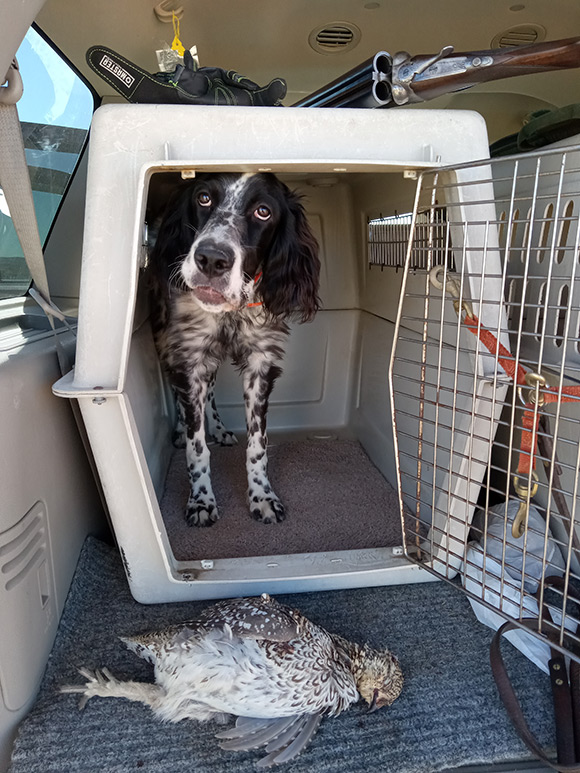
Willa in kennel crate, with sharptail – Young Willa was blooded to sharptails last fall.
This year we’ll see what she’s made of.
Illinois’s IRAP squirrel hunting
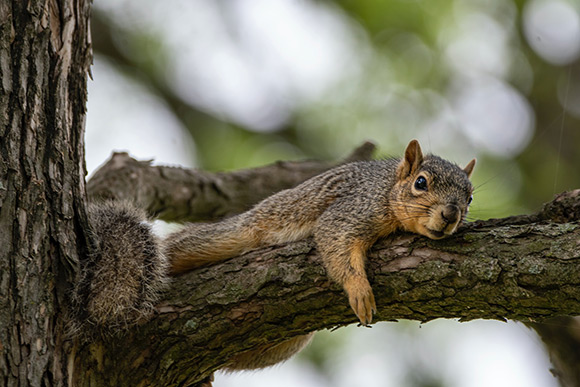
Squirrel on a limb - photo by Trac Vu/Unsplash
Want to hunt squirrels? Illinois has more than 4,400 acres on 30-plus private land hunting sites in 18 counties enrolled in the state Department of Natural Resources’ popular IRAP (Illinois Recreational Access Program) effort. IRAPs are open through September 15 for squirrel hunting and available at no cost. Hunters simply register, sign a liability waiver, and reserve a site through IRAP’s online registration system: https://dnr.illinois.gov/conservation/irap/irapregistration.html. Registered participants can add up to three additional registered hunters to their reservation for a group hunt. All hunters will receive a valid site permit that must be carried on their person and a windshield card that must be placed in their vehicle after reserving their site. Youth hunters 17 and younger must be accompanied by an adult supervisor (a parent or a designee of their parent who is at least 21). Both youth and their supervisors must register and reserve a site online. Once hunters have successfully reserved their site, they can download a site-specific permit to print and take with them on their hunt, along with directions and a map with coordinates. More information about IRAP’s squirrel hunting sites can be found online at https://dnr.illinois.gov/conservation/irap/small-game-hunting.html. For more information visit https://dnr.illinois.gov/conservation/irap.html or contact DNR.IRAP@illinois.gov.
Wisconsin Wants Public Input on Wolf Management
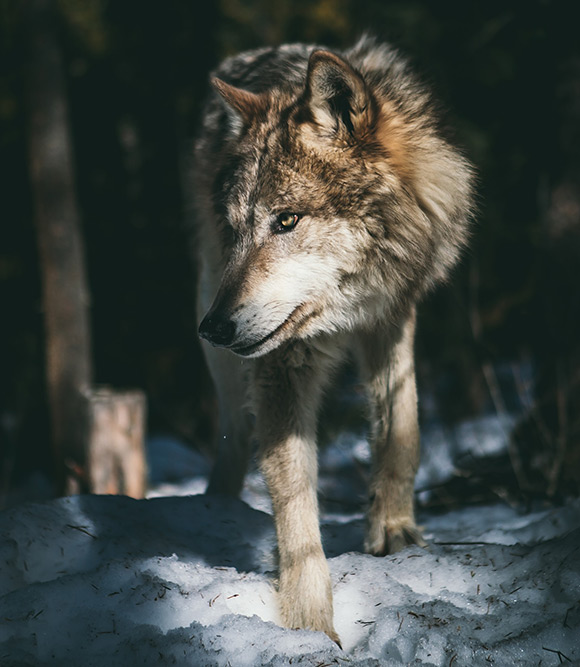
Wolf - photo by Andrew Ly/Unsplash
The Wisconsin Department of Natural Resources (DNR) is seeking public comment on proposed permanent rules relating to gray wolf harvest regulations. The public comment period is open through Sept. 15, 2023. The rules applying to wolf regulations are available by visiting https://dnr.wisconsin.gov/topic/wildlifehabitat/wolfmanagementplan. A virtual public hearing on the proposed rule will be held on Tuesday, Sept. 12, at 4 p.m. The public can provide verbal comments on the draft rule at the hearing. Pre-registration is strongly encouraged. To pre-register, download and complete a Hearing Appearance form and send it to ScottR.Karel@wisconsin.gov. The DNR will accept written comments on the proposed rule by mail, email or online. The public can review the rule and make comments online, visit https://docs.legis.wisconsin.gov/code/chr/hearings. All comments will have the same weight, including the verbal statements presented at the public hearing. Written comments on the proposed rule will be accepted until 11:59 p.m. on Sept. 15, 2023. Please direct written comments to: Department of Natural Resources, Attn: Scott Karel, P.O. Box 7921, 101 S. Webster Street, Madison, WI 53707-7921 DNRAdministrativeRulesComments@wisconsin.gov
Ginseng Sting Nabs 110 Ohio Violators
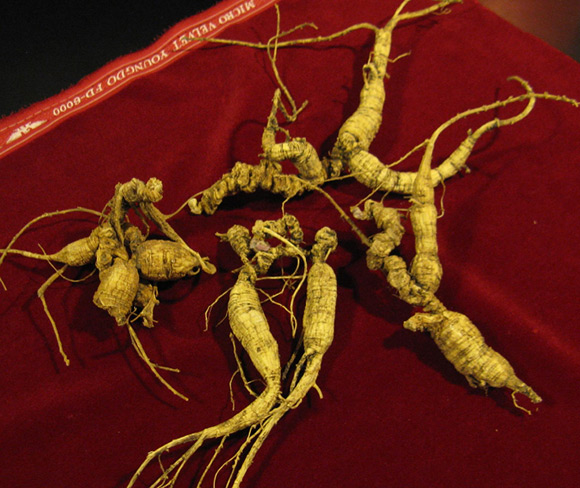
American ginseng - John Carl Jacobs /Creative Commons
The Ohio Department of Natural Resources’ (ODNR) Division of Wildlife and the U.S. Fish and Wildlife Service recently concluded a two-year investigation into illegally harvested and dealt ginseng. The investigation targeted licensed and unlicensed ginseng dealers and out-of-season diggers. Ohio wildlife officers and investigators executed search warrants, cell phone record warrants, and GPS tracking warrants to compile evidence. The operation involved the illegal trafficking of ginseng in 21 Ohio counties, and in West Virginia, Virginia, New York, Kentucky, Pennsylvania and Indiana. A total of 110 defendants were charged with 259 combined violations, including the illegal harvest of ginseng, falsification or failure to keep ginseng records, illegal purchase of ginseng and harvest of ginseng without permission. Also, during the investigation, seven individuals were charged for the manufacture, possession or sale of illicit drugs. Defendants will pay more than $76,000 in combined fines and nearly $22,000 in court costs, with an additional $21,000 in cash being forfeited. Courts ordered nearly 8,000 days of jail time. Only 2,000 days were served, the rest were suspended. Those convicted on drug-related crimes will serve 12 to 15 years in prison. Additional penalties included probation, community service, home confinement, suspension of ginseng dealer permits, and suspension of digging ginseng. American ginseng is a slow-growing perennial herb found throughout Ohio in small, scattered populations and is highly valued for its medicinal properties. Ohio is one of 19 states with a ginseng management program, designed to maintain a sustainable yield of the plants. Ohio ginseng can only be harvested between September 1 and December 31, annually. Harvest is limited to mature plants (at least three leaves) and harvesters are required to plant the seeds of collected plants where they were found. Ginseng diggers must have written permission to collect ginseng on private and public lands. Visit wildohio.gov to learn more.
Montana requires bird dog training license
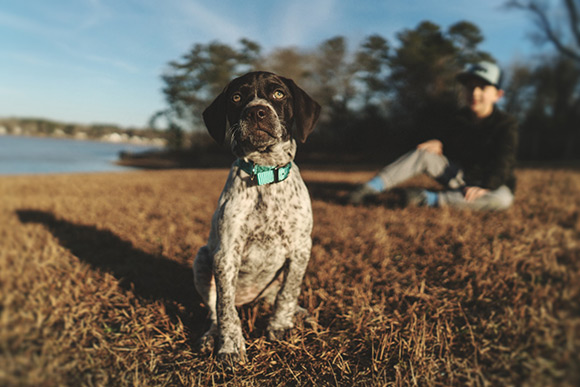
German shorthair pup - photo by Clint McKoy/Unsplash
Anyone training bird dogs in Montana using game birds not raised in captivity needs to get a bird dog training license, whether on private or public land. The license is a new requirement from the 2023 Legislature. Those training dogs with captive-reared birds do not require a license. The licenses can be purchased online through FWP’s online license service, https://fwp.mt.gov/buyandapply, via any FWP regional office or any license provider. The license is $5 for residents ages 18 and over, $10 for nonresidents 18 and over. For residents and nonresidents ages 12 to 17, the license is free. Bird dog training season with wild birds on public lands began Aug. 1 for residents and Aug. 15 for nonresidents and ends March 31, 2024.
Minnesota Grouse Counts Up
.jpg)
Ruffed grouse
Minnesota’s spring ruffed grouse population counts are up again, like other recent peaks in the 10-year population cycle of grouse — a pattern recorded for 72 years – says the Minnesota Department of Natural Resources (MDNR). The DNR uses spring drumming counts to help monitor the ruffed grouse breeding population across time. The recent grouse population trend includes a low point in the cycle in 2021 (not as low as previous lows), followed by unexpectedly higher counts in 2022 and again this year. Warm temperatures and dry conditions favoring high nest success and chick survival the past two years may partly explain the rise. Snow conditions also were favorable for roosting throughout much of the core of grouse range during the past two winters. “While ruffed grouse drumming counts are up in the core of ruffed grouse range, they are not an accurate way to predict the birds that will be present during the fall hunting season,” said Charlotte Roy, DNR grouse project leader. “Nesting success and chick survival during the spring and summer are among the factors that influence the number of birds present in the fall.” The ruffed grouse survey report can be found on DNR’s grouse management webpage mndnr.gov/wildlife/grouse.html.
Mountain Lion in Omaha, Nebraska Lion Season Approved
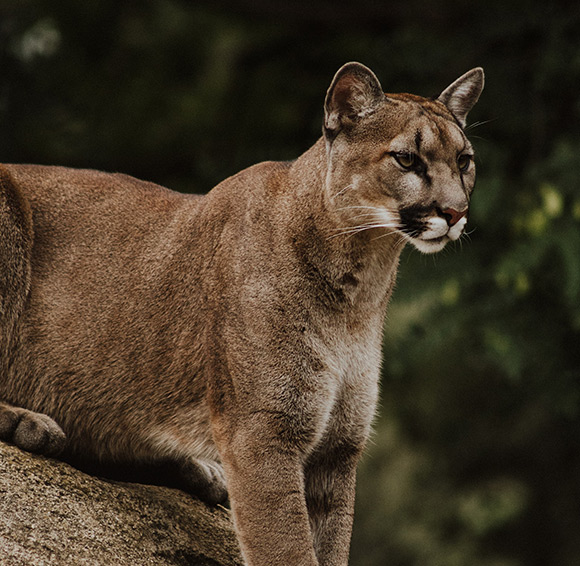
Mountain lion - photo by Priscilla Du Preez/Unsplash
The Nebraska Game and Parks Commission (NGPC) confirmed that a mountain lion was present in Omaha on August 2 via tracks and photo evidence. The animal was moving south along Papillion Creek between Interstate 80 and 96th Street. Also, a probable but unconfirmed lion sighting took place when a Game and Parks law enforcement officer and the Sarpy County Sheriff’s Office responded to a reported mountain lion east of Walnut Creek Recreation Area, near Papillion, on August 3. NGPC and other agencies will continue to monitor and search for these animals. People should call Game and Parks or local police if they observe a mountain lion. NGPC urges people to not approach a lion, leave the animal an avenue of escape, and to move slowly and back away from the cat, don’t run. Cougar attacks are rare. Meanwhile, in June, NGPC approved a new 2024 mountain lion hunting unit, outside the Pine Ridge. The newly created Niobrara Unit includes parts of Brown, Cherry, Keya Paha, Rock and Sheridan counties. Nebraska mountain lions are part of the larger western population in Colorado, South Dakota and Wyoming. The cats have been in the Niobrara River valley since 2001, with a resident reproducing population there since 2013. Season 1 in the Niobrara and Pine Ridge units will take place Jan. 2 – Feb. 29, 2024 . The season ends immediately in Pine Ridge if four mountain lions with a sub-limit of two females is reached, and in the Niobrara unit if two mountain lions with a one female sub-limit is reached. The Pine Ridge Unit will have 320 permits available, the Niobrara Unit 160 permits, all issued by lottery. An auxiliary season could be held March 16 – 30 if the annual harvest limits or female sub-limits are not reached.
New Rule on Importing Canada-Harvested Game Birds Into the U.S.
There’s good news for U.S. waterfowlers or bird hunters bringing home game birds from Canadian hunts. The U.S. Department of Agriculture’s Animal and Plant Health Inspection Service (APHIS) 2023 rule for importing game birds into the U.S. from Canada now allows the skin to remain on hunter-harvested carcasses. Under last year’s rule – designed to limit the spread of highly pathogenic avian influenza (HPAI) – APHIS required hunters to remove skin from harvested game birds from Canada, among other restrictions. After close consultation with waterfowl scientists from Ducks Unlimited (DU), APHIS’s 2023 rule eliminates that requirement, but all other restrictions remain the same. Unprocessed hunter-harvested wild game bird carcasses originating from Canada must have the viscera, head, neck, feet and one wing removed. And, except for that one wing, as required by U.S. Fish and Wildlife Service (FWS) for species identification, all feathers should be removed. Carcasses must be rinsed in fresh, clean, potable water prior to packaging them in leak-proof plastic packaging. They must have no visible evidence of contamination with dirt, blood or feces. Also, carcasses must be chilled or frozen during transport and import. For more details on restrictions USDA APHIS recommends hunters visit www.aphis.usda.gov/aphis/ourfocus/animalhealth/animal-disease-information/avian/avian-influenza.
New York’s Latest Invasive Species: The Elm Zigzag Sawfly
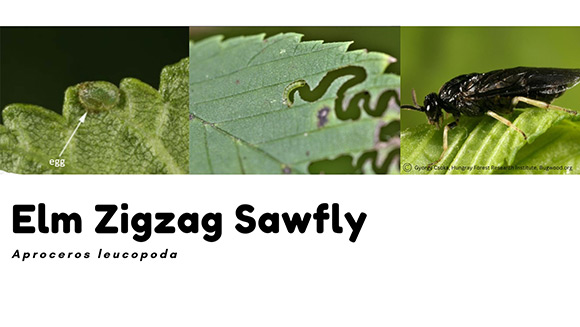
Gyorgy Csoka/Hungary Forest Research Institute, Bugwood.org
The elm zigzag sawfly (Aproceros leucopoda) is an insect that only eats elm leaves and can cause severe defoliation that threatens tree health. They get their name from the easily recognizable “zigzag” feeding pattern larvae create as they chew through leaves. However, when most of the tree's leaves have been eaten, the zigzag pattern may not always be as clear because larvae will eat all the leaf tissue down to the vein. If you see the zigzag pattern or suspicious defoliation of elm trees, please report it on the iMapInvasives website (www.nyimapinvasives.org), or email photos to foresthealth@dec.ny.gov.
USGS deploys vehicles to improve Lake Erie fishery
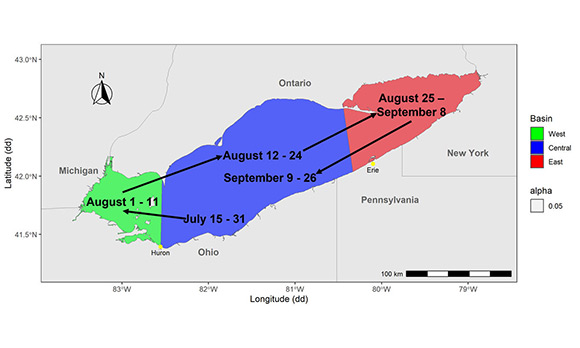
Map showing when drones will be where,
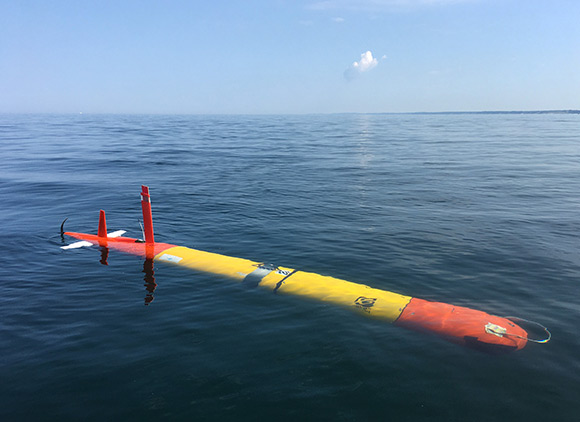
Torpedo-like long-range autonomous underwater vehicle (LRAUV).
The U.S. Geological Survey has been using autonomous surface and underwater vehicles on Lake Erie since mid-July – the study will end in September – to improve fishery surveys across the entire lake. In July, a wind and solar-powered uncrewed surface vehicle called a Saildrone Explorer was launched on Lake Erie out of Erie, Pennsylvania. The vehicle is equipped with several environmental sensors both under and above the water, including a fisheries echosounder that uses sound to detect fish, much like a fish-finder. The saildrone will operate in Lake Erie’s western, central, and eastern basins, circumnavigating the lake in a clockwise direction through the end of September. In addition to the saildrone, a long-range autonomous underwater vehicle (LRAUV) will be deployed near Fairport Harbor, Ohio for one week in mid-September. The LRAUV is operated by the Monterey Bay Aquarium Research Institute (MBARI) and will travel at 5 to 15 meters depth. “Monitoring Lake Erie fish populations is integral to sustainable management of the recreational and commercial Lake Erie fishery,” said David Nihart, Fisheries Management Chief for the Pennsylvania Fish and Boat Commission and Chair of the Lake Erie Committee. “But fish community changes and dynamic habitat conditions often create monitoring challenges. We are excited to collaborate with the USGS to explore the use of autonomous vehicles for monitoring Lake Erie fish populations and fisheries.” Previous Lake Erie acoustic fisheries surveys were conducted using relatively loud diesel-powered research vessels. The saildrone and the LRAUV are quieter and may detect more fish swimming closer to the surface than noisy vessels which can scatter fish. The LRAUV operates in the middle of the water column and has sensors looking up and down. It may detect bottom- and surface-dwelling fish more accurately. Scientists will compare the data gathered using each platform to address potential sampling biases. Notices regarding both autonomous vehicles have been provided to mariners via the U.S. Coast Guard. The acoustic technology used in the study is not hazardous to people or animals and will not interfere with sonar, communications equipment, or similar electronics. Boaters are asked to maintain a safe distance of 1,500 feet from the saildrone.
Women Injured by Jefferson River otter
Three women were injured by an otter recently while floating Montana’s Jefferson River. About 8:15 p.m., the three women were floating on inner tubes when they observed one or two otters. An otter approached and attacked them. The women got out of the water, and the otter swam away. The women then called 911, and several agencies responded, including Montana Highway Patrol, Jefferson County Sheriff’s Office, Jefferson Valley Ambulance, and Montana Fish, Wildlife & Parks (FWP), Life Flight and a local landowner. All three women were injured during the encounter and received medical treatment in Bozeman. One of them, whose injuries were more serious, was taken to the hospital in a helicopter. FWP posted signs at several fishing access sites in the area advising recreationists of otter activity. While attacks are rare, otters can be protective of themselves, their young, especially at close distances, and food resources, especially when those resources are scarce. FWP advises recreationists to keep a wide distance, giving all wildlife plenty of space. In drought conditions, low water levels can bring recreationists closer to water-dwelling wildlife. Being aware and keeping your distance can help avoid dangerous encounters, reduce stress for wildlife, and promote healthy animal behavior.
Alabama Turkey Harvest Up, Population Debate Continues
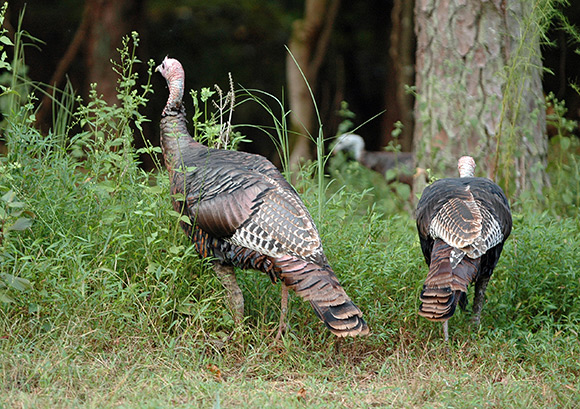
Turkey debate continues. - photo by ADCNR
The Alabama Department of Conservation and Natural Resources’ (ADCNR) Game Check reports say turkey hunters harvested almost 2,500 more birds during the 2023 season than the 2022 season. However, whether that’s thanks to a rising turkey population is subject to significant debate. Hunters reported taking 18,122 birds during the 2023 season, compared to 15,673 during the 2022 season and 14,947 during the 2021 season. Chuck Sykes, ADCNR wildlife director, said the harvest shouldn’t be construed as an increase in the turkey population. Sykes focused on the first 10 days of the past three seasons to illustrate how increasing hunter numbers may skew turkey harvests: During the 2021 season, 3,808 hunters reported 4,488 birds harvested. The same time for the 2022 and 2023 seasons showed more hunters (6,062 hunters in 2022 and 6,325 in 2023) and a corresponding increase in reported harvests (7,391 in 2022 and 7,845 in 2023). “Does that mean there are more turkeys out there,” Sykes said. “I don’t think so. Only time will tell.” Sykes is also concerned about the motivation of today’s turkey hunters compared to previous generations. In the past, hunters sought challenge, he said, “I don’t see that today. I’m not saying everybody. No matter what rules and regulations we put in place, no matter what science we come up with, we can’t legislate or regulate morals and ethics.” Sykes studied the contacts conservation officers had with turkey hunters during the first 10 days of the 2023 season and was disheartened. More than half the counties had citations written for offenses including hunting over bait (the most, more than 80 citations), hunting without a license, adults hunting during youth weekend, hunting prior to the opening of the season and using decoys the first 10 days of the season. Sykes said modern technology has become so sophisticated that the sense of fair chase has been marginalized. The agency needs to consider that people are much more effective killers today, he noted. Veteran hunters remember when Alabama’s turkey population was not abundant, if a hunter heard a turkey gobble it was considered a successful hunt. “I think until people respect the bird and love the hunt and love the bird more than they love themselves, the birds are in trouble,” Sykes said. “People are turkey shooters now, not turkey hunters.” Also, Steven Mitchell, ADCNR upland game coordinator, is concerned that hunters are not reporting their harvests through Game Check as mandated. Mitchell said reporting compliance is averaging 45% during the last five years but needs to much higher so ADCNR can use the most complete and accurate data to manage turkey populations.
Living with wildlife: bats in your house?
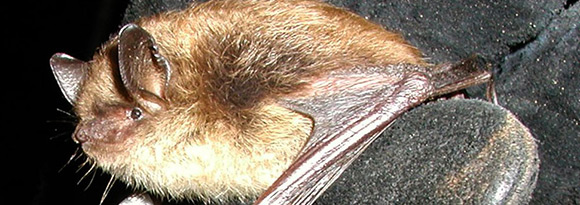
Bat colonies are starting to disperse now that young bats can fly. Fall is a good time to think about safely evicting bats from where they are not wanted. - photo by VFW
Summer is when some bat species gather in colonies to raise their young in houses, barns, office buildings and other structures. Fall is the safe time to get them out, says Vermont Fish and Wildlife (VFW). The greatest number of unwanted bat-human interactions are reported during summer, says VFW’s Small Mammals Biologist Alyssa Bennett, who works on the conservation and recovery of Vermont’s threatened and endangered bat species. Bats can end up in living spaces for many reasons, including young bats that are weak, disoriented or lost while going to and from the roost, bats moving within a structure to find warmer or cooler roosting space as temperatures fluctuate, and bats being displaced from their roosts due to building repairs and renovations, Bennett noted. “Living with wildlife doesn’t mean that we have to share our homes with bats in order to protect them,” says Bennett. “Our main concerns are avoiding human contact by safeguarding the living space, evicting bats from structures safely, and providing alternative habitat for displaced bats.” When young bats can fly, colonies start to disperse. So, fall is a good time to think about safely evicting bats from structures where they are not wanted by following VFW’s Best Management Practices. These are available at vtfishandwildlife.com/learn-more/living-with-wildlife/got-bats, or by calling (802) 353-4818, or emailing Alyssa.Bennett@vermont.gov, where you can also obtain a list of professionals who perform safe evictions.
Washington seeks public input on fish passage rules
The Washington Department of Fish and Wildlife (WDFW) is looking for public feedback on proposed fish passage and screening rules intended to support salmon and orca recovery. The public is invited to a virtual public meeting, scheduled for 1:30 to 3:30 p.m., Wednesday, Sept. 13, to learn more and provide input. The proposed rule would formalize existing design standards for diversion screens and fish passage, introduce a climate adapted design standard for water crossings, and outline procedures that support regulatory compliance. New rules are anticipated to go into effect in 2023. The public can reference the proposed rules on WDFW’s website and provide feedback by email to fish-passage-rules@PublicInput.com, online, or by phone (855-925-2801 project code 4535). The proposed rules are also undergoing a state environmental review process, referred to as a State Environmental Policy Act (SEPA) review. WDFW is accepting comments as part of that environmental review online and by email to FishPassageScreeningRules@PublicInput.com. Reference the WDFW website for more information. The Department is accepting comments through Sept. 29, 2023.
What’s Coming in October
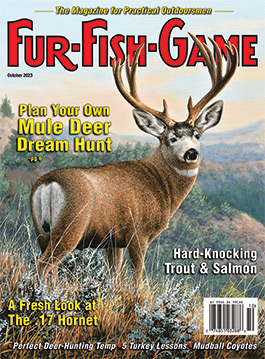
A Western Calling - Missourian Will Bowen and his father plan and share a rifle hunt for big mule deer bucks in New Mexico.
Mudball Coyotes - Mike Schoonveld tells you how to turn muddy, dirty fur, particularly coyotes, into more money using his “process” of cleaning fur.
A Sons-Only Pronghorn Hunt - Casey Freise shares the experiences of two fathers and their sons on a Wyoming sons-only pronghorn hunt.
Forty Degrees - Is there a magic temperature that foreshadows good deer hunting? Jeffrey Miller says that temperature is 40 degrees and tells you how to capitalize on 40 degree deer.
Two Bulls In Six Days (Part II) - Joe Cella’s tale of three archery hunters embarking on a DIY elk hunt in prime Colorado elk territory concludes.
Other stories include:
• Illinois Squirrel Hunting – Two experienced hunters, Charles Hage and Wes McNett, offer squirrel hunting tips along with a plan for making a squirrel skinning tool.
• Hunting Alaska’s Brown Bears – Hugh Bevan takes a how-to look at fall and spring bear hunts in southeastern Alaska.
• Hard-Knocking Fall Trout/Salmon – Rob Dankowsky details aggressive tactics for catching fall trout and salmon in the Upper Midwest’s waters.
• Five Lessons Learned – Turkey master Bruce Ingram shares the frustrations and means to overcome them that fall turkeys have taught him over time.
• A Canine Trappers Tactics – Casey Rayls looks at how to avoid trap thieves and catch canines during deer season.
End of the Line Photo of the Month
Grant Massey, St. Ignace, Michigan
SUBSCRIBE TO FUR-FISH-GAME Magazine

